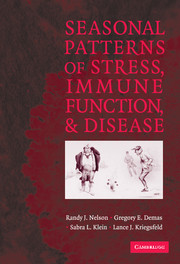Book contents
- Frontmatter
- Contents
- Acknowledgments
- Foreword
- Preface
- 1 Seasonality
- 2 Immune Function
- 3 Seasonal Fluctuations in Disease Prevalence
- 4 Seasonal Changes in Immune Function
- 5 Photoperiod, Melatonin, and Immunity
- 6 Energetics and Immune Function
- 7 Hormonal Influence on Immune Function
- 8 Clinical Significance of Seasonal Patterns of Immune Function and Disease
- References
- Index
3 - Seasonal Fluctuations in Disease Prevalence
Published online by Cambridge University Press: 11 November 2009
- Frontmatter
- Contents
- Acknowledgments
- Foreword
- Preface
- 1 Seasonality
- 2 Immune Function
- 3 Seasonal Fluctuations in Disease Prevalence
- 4 Seasonal Changes in Immune Function
- 5 Photoperiod, Melatonin, and Immunity
- 6 Energetics and Immune Function
- 7 Hormonal Influence on Immune Function
- 8 Clinical Significance of Seasonal Patterns of Immune Function and Disease
- References
- Index
Summary
All diseases occur at all seasons of the year, but certain of them are more apt to occur and be exacerbated at certain seasons.
Hippocrates, 400 B.C. AphorismsIntroduction
Seasonal fluctuations of illness and death among humans and nonhuman animals have been recognized for centuries. In most cases, people assumed that factors associated with the changing seasons brought about illness and death. Seasonal patterns were observed in the timing of disease onset and in the severity of symptoms. It was noted that there is “a time to be born”, as well as “a time to die”, and “a time to heal” (Ecclesiastes 3:2–3). In early Greek medicine, seasonal changes in climate or other environmental factors were thought to be central in causing many afflictions, including consumption (pulmonary tuberculosis), boils, asthma, ulcers, and lesions. Hippocrates observed that, “in autumn, diseases are most acute, and most mortal, on the whole. The spring is most healthy, and least mortal”. In his Aphorisms, Hippocrates noted many relationships between the weather, seasons, and temperament of the patient, and the onset or severity of various diseases. For example, he wrote, “if the winter be of a dry and northerly character, and the spring rainy and southerly, in summer there will necessarily be acute fevers, opthalamies, and dysenteries, especially in women, and in men of a humid temperament.” Although the associations observed by early physicians were often based on isolated cases, these correlations between disease and environmental conditions continued to influence medicine for the next 2000 years. Many superfluous correlations were established, and these correlations often evolved into erroneous causative arguments. With the widespread adoption of the germ model as the etiological heuristic in the nineteenth century, the influences of seasons and patient personality in disease processes were virtually abolished in Western medicine.
- Type
- Chapter
- Information
- Publisher: Cambridge University PressPrint publication year: 2002
- 2
- Cited by



